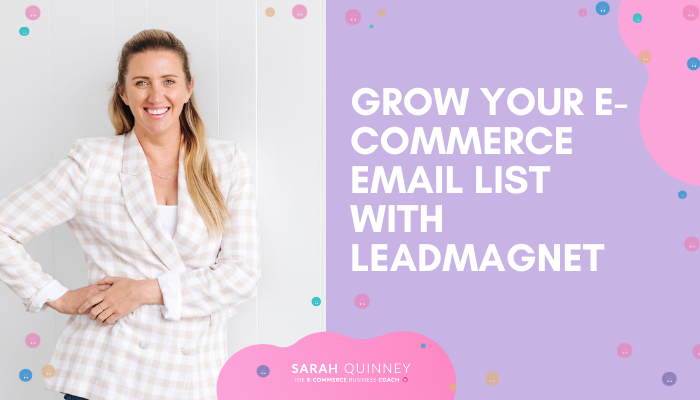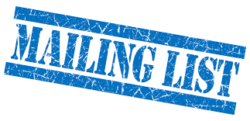
Grow Your E-Commerce Email List with Leadmagnet
Increase conversions and build an email list to grow your business!
If you can’t convert website visitors into customers the first time they land on your site, collect their information such as their email address.
If you haven’t built an email list yet, you should start yesterday.

But let’s say you already have a list. You put up a form on your site to collect email addresses, so you can stay in touch. You wait. You wait some more.
Nothing.
Your website is underperforming.
Maybe you get half a percent of visitors to sign up.
What if you could drive that number up? If you could increase your conversion rate conversion rate—what would that do to your business?
Here is an example:
Say you have a website that brings in 10,000 visitors per month, with a conversion rate of .5%. That means your email list grows by about 50 subscribers every month.
If your average revenue per email subscriber is $7, you’re bringing in $350 of revenue per month—just from your website traffic.
What happens if you increase your conversion rate? We’ll keep all the other numbers the same, but plug in a conversion rate of 4%.
At 10,000 visitors per month, a 4% conversion rate brings you 400 new email subscribers every month. At an average of $7 per subscriber, that’s $2800 of revenue—over the course of a year, that’s almost 30,000 extra dollars that you generate without any extra work.
So the question is – how can you grow your list, get more leads, and (eventually) get more sales to grow your business?

Here’s the single most effective way to build your email list and increase conversions: lead magnets.
What is a lead magnet?
You may have heard the term lead magnet before. If not, they go by a lot of different names you could have heard of:
- Opt-in incentive
- Signup offer
- Opt-in offer
- Opt-in bribe
- Carrot
- List bait
So what is a lead magnet?
It is a lead generation technique to get more people to give you their email address.
Specifically, a lead magnet is when you offer something—be it a checklist, ebook, consultation, or trial—in exchange for an email address.
Instead of asking people to “subscribe to your newsletter,” which isn’t really that compelling, you offer them some kind of content or service that solves their problem.
Does a lead magnet get you more customers?
Not right away. But by collecting information from people interested in what you have to say, you can follow up with nurture campaign sequence and convert sales that would have been otherwise nonexistent.
How you create a lead magnet?
If you have design chops or video editing skills, creating a lead magnet won’t be too difficult for you. Just use the Adobe product suite, or Final Cut, or your preferred software and get crackin’. The hard part for you is finding the right lead magnet ideas (which we’ll cover).
But if you don’t know much about design , it’s still possible to make compelling opt-in offers.
You can shoot and edit simple videos on your phone—the production quality isn’t incredible, but it gets the job done if your message is interesting.
For downloadable documents (which are much more common opt-in incentives), you can use some combination of Google Docs, Microsoft Word, and the free design service Canva.
Google Docs and Microsoft Word both let you export documents as PDFs—which you can then upload to your website and deliver to people in a link.
Canva is an awesome design service that lets you make simple graphics. It has a super easy to use interface that lets you drag and drop things into place.
How do I deliver a lead magnet?
Let’s look at some lead magnet ideas—and what makes a great lead magnet.
Once your lead magnet is created, you need a way to offer and send it to people who subscribe. Email is usually the best way.
By building a custom form for your site (which you can embed anywhere you like), you can offer different magnets on different pages. In CRM’s and email management systems lead magnets get delivered through forms and automations.
Then, once a form is filled out, you can trigger automated emails that deliver the lead magnet—and even start an email sequence.
And, of course, you can subscribe people to your lists and add tags whenever they complete a form.
What types of lead magnets should you create?
Different types of opt-in offers, to help spur lead magnet ideas.
- Checklists are a fantastic lead magnet idea for two simple reasons:
They’re easy to use.
They’re easy to make.
The most effective lead magnet ideas offer things that can be used immediately. If you want to get someone’s information, you have to entice them with a pretty strong offer—and they’re going to want the benefits of that offer right away.
Checklists fit the bill! A one-page outline for a specific process gives your subscribers all the information they need in a single glance.
 2. Cheat Sheets
2. Cheat Sheets
Wait, what’s the difference between a checklist and a cheat sheet?
Cheat sheets are similar to checklists, but tend to have a bit more information. Instead of showing steps to a process, a cheat sheet will usually have background information on a specific topic—for when you need to see it at a glance.
3. Ebooks and Guides
Ebooks and guides are one of the most common lead magnet ideas.
If you decide to use an ebook as a lead magnet, you should keep the copy tight. It can be long—especially if you’re providing massive value—but it needs to stay engaging throughout.
Guides and ebooks can be really useful ways to increase conversions, and they’re really easy to put together—just write it and export as a PDF.
The key to using an Ebook as a lead magnet is to ensre you have identified aspecific niche’s and created offers that solve specific problems. Reading a guide or ebook is a time investment—but people will do it if they think it will solve their problems.
 4. Free courses
4. Free courses
One of the simplest ways to create a lead magnet is to offer a free email course.
Creating a free email course takes almost zero technical know-how. You don’t need to know how to design anything.
The structure of a free course is straightforward—just send emails.
As long as your free email course solves a major pain point, it can be an effective lead magnet.
The gratification for an email course isn’t immediate (people have to wait for each email)—but there’s something to be said to having contacts look forward to your emails. For that reason, email courses are often a really nice segue into lead nurture campaigns.
5. Free videos
Video is an engaging form of content, but some people are nervous about using video lead magnets because of how hard it is to create them.
At the same time, videos can make really effective lead magnets for two reasons:
They are extremely consumable
They have a high perceived value
For most people, watching a 9-minute video takes less effort than reading a 20-page ebook. And because video is relatively more difficult to produce, the people that do produce it have an advantage—people think it’s valuable.
Making videos can be easy!
Yes, great production value is hard. Video editing can be difficult. If you run an established business—or the type of business where your customers expect your work to have high production quality—you really do need to have that production.
Also, having the resources and know-how to make great videos opens up more options for the types of videos you can produce.
But for many small businesses most of the time, people aren’t expecting outrageous production. If you have a message that would be easiest to relay through video—shoot it on a phone or starter camera.
The video doesn’t need to be anything spectacular from a production standpoint, just ensure the content is engaging and relevant to your customers.
6. Reports
Reports tend to be more appealing to a technical or B2B audience. But if you’re in that type of industry, they can be a powerful lead magnet.
Knowing industry benchmarks and trends is really valuable—so valuable that some reports cost thousands of dollars to access. If you have the capability to offer some kind of valuable report for free, it can be a powerful lead magnet.
7. Free trials
Free trials are an incredibly common lead magnet.
If you have a product you can offer for a limited time, there’s no better way to show potential customers what they could be getting. Especially when products are expensive, customers are much more likely to buy if they can try your platform for themselves.
You can offer a free, 14-day free trial, a free introduction to a course the list goes on.
 8. Coupons and discounts
8. Coupons and discounts
A lot of the examples so far—for guides, checklists, and videos—are harder to pull-of in certain industries. Downloading a checklist from an ecommerce site is kind of a tough sell.
That’s why a lot of ecommerce sites use a different type of lead magnet—one that’s specifically tailored towards their business model.
Coupons and discounts can be an effective way to collect email addresses—and sometimes convert directly into customers. Saving money is compelling. Because a huge part of ecommerce is picking up first-time buyers, it makes sense to use coupons to attract them.
A lot of ecommerce sites keep their subscriptions simple, saying something like “sign up to get notified of the latest deals.” That’s ok, but it can be taken a step farther.
Offer a 20% discount for signing up to your email list.
If you’re interested in a product but not convinced, a coupon might be just the push you need to give up your email address. That makes them an attractive lead magnet.
- Templates and examples
If you have artistic ability that your audience needs, creating a template or sample can be and effective way to show value.
9. Consultations
In a lot of service-based industries, free consultations can be a great lead magnet.
Sometimes all people want is the chance to speak to an expert about their problems. In a lot of cases, you might be able to answer questions in minutes—when those same questions would have taken hours of Googling for people to answer on their own.
On your end, a consultation helps you qualify leads by figuring out two things:
Whether you’re the best fit to help someone with their problem.
Whether they have the willingness to pay for help
Offering both a consultation and a free guide can help you further qualify leads. Consultations can be effective, but they also take up time. Ideally, prospects towards the bottom of the funnel take the consultation—while everyone else uses the free guide.
10. Quizzes
Who doesn’t love taking online quizzes? BuzzFeed proves that quizzes can be a way to generate massive traffic and engagement.
Quizzes can also be used as a great lead magnet—and because they make people choose between
11. Webinars
If you run webinars to sell your products—or just for thought leadership—you’d probably like to make your investment in them evergreen.
Webinars are a common lead generation tactic, but what do you do with the recording once the event has ended?
Include an offer to sign up for your email list, book an app ect.
Webinars are closely related to videos, but can be a bit different. They tend to be longer form, and often involve having slides with voice-overs instead of actually featuring you on camera.
The truth is, not all lead magnet ideas fit neatly into one of the above categories. But any type of lead magnet can be effective if it solves your audience’s need.
So, what makes some lead magnets better than others?
What makes a good lead magnet?

What are the key characteristics of effective lead magnets?
- Targeted at a specific problem
A great lead magnet solves a problem.
When you create a lead magnet, it’s tempting to throw in everything and the kitchen sink. Doesn’t it make sense to give leads everything they possibly want?
Eventually, yes. But not at first.
If you bombard people with a dozen different messages, you can freeze them into inaction.
But if you give them a single message to focus on, one that solves an acute, burning pain—who wouldn’t take action?
When you create your lead magnet and write your opt-in copy, make sure you keep in mind—what problem are you trying to solve? Why are you the one that can solve it?
- Targeted at a specific audience
Along with targeting a very specific pain point, lead magnets are more effective when they can target a niche audience.
What if you run a slightly more general business?
Segment your audience.
If your products can apply to multiple different audiences—segment!
Offering lead magnets specific to each audience will improve your conversion rates.
- Offers a (perceived) quick win
The best lead magnet ideas solve a problem right now.
Why do people download your lead magnet? Because it solves a problem. People with problems want those problems solved as quickly as possible—ideally with as little work as possible.
That’s why checklists and videos work really well as lead magnets—they promise to solve problems and they are easy to consume immediately.
When you create a lead magnet, your job isn’t to give people what they need. It’s to give people what they think they need.
In a perfect world, what people actually need would be the same as what they think they need.
Bonus:

The 3 best ways to boost lead magnet conversion rates
You have followed the best practices for lead magnets, put a lot of effort into making one, and still don’t have a good conversion rate?
One thing you might be tempted to do is jump straight into conversion rate optimization (CRO). You might get ready to do a ton of split testing, and a/b test every part of your page to increase conversions.
Eventually, split testing is the best way to increase conversion rates. Before you sink a lot of time, energy, and money into split testing—make sure you’re following some simple best practices.
If you implement these changes and still don’t see much change to your conversion rates, go ahead and think about split testing (or even take a step back and consider your overall positioning).
But here are a few quick wins that can increase conversions before you go all-in on conversion rate optimization.
- Use a pop-up
If the idea of adding a pop-up form to your website makes you uncomfortable, consider using an “exit-intent” pop-up, they only appear when a visitor is about to leave your site. That way, you can collect contact information without interrupting the viewing experience on your website.
Most of the popular list building tools can create an exit-intent form, and using one could help you make the most of your lead magnet.
- Copy
Copy may be the most overlooked and most powerful way to improve conversion rates.
It seems a little strange to call copy overlooked. Doesn’t everyone know that you need to have opt-in copy?
Yes. But there’s a huge difference between having copy and having copy that converts.
Copywriting is an entire field—some people spend their entire career focusing on just copy.
If you just need to get more conversions for your lead magnet, try to follow these five copy guidelines.
- Clear writing: If people don’t know what you’re offering them, they won’t convert. Get rid of marketing-speak, and don’t try to write clever puns until your offer is crystal clear.
- Natural language: Speak simply. Write plainly. Avoid using a lot of jargon, and sound conversational. The easier it is to understand what you’re saying, the more likely people are to convert.
- Benefits: You can offer someone a guide, checklist, video, or report. But why should they want it? Make sure you tell people how your lead magnet will help them.
- Emotion: The strongest copy is emotional. Your lead magnet solves a burning pain for your audience. Make sure your copy reflects that pain—make sure they feel like your lead magnet can solve it.
- A call to action: As silly as it sounds, people won’t download your lead magnet just because it’s there. You need to tell them to sign up with a clear CTA.
A great headline is the first step to grabbing attention, especially if you’re using a popup to increase conversions. You need to get attention fast—and a boring headline is the best way to get people to close out your popup.
The great copywriting extends all the way to the call to action (CTA) copy. “Show me.” Isn’t that much more compelling than “learn more”—or even worse, “submit?”
Look for ways to amp up the emotion and clarity in your opt-in copy. You’ll increase conversions quickly.
- Use a content upgrade
A content upgrade is a subset lead magnets in general. When you have a high-performing blog post on a specific topic, you have an opportunity to offer a content upgrade.
Instead of offering your standard, generic lead magnet, why not point people to a lead magnet that’s specific to the content that they just read?
If you’re having trouble getting conversions, consider creating content upgrades for the pages of your site that have the most traffic. You’ll increase conversions on blog posts pretty quickly.
By delivering value up front, you can convert more of your website visitors into contacts—and get more sales from leads who would otherwise have disappeared.

